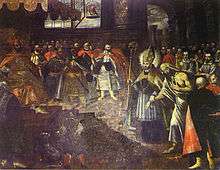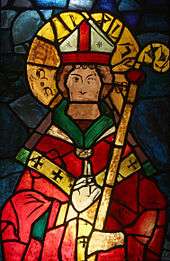Stanislaus of Szczepanów
| Saint Stanislaus of Szczepanów | |
|---|---|
|
Saint Stanislaus | |
| Bishop and Martyr | |
| Born |
July 26, 1030 Szczepanów, Poland |
| Died |
April 11, 1079 (aged 48) Kraków, Poland |
| Venerated in | Roman Catholic Church |
| Canonized | September 17, 1253, Assisi, Italy by Pope Innocent IV |
| Major shrine | Wawel Cathedral |
| Feast | April 11, May 7 (Traditional Roman Catholics), May 8 (in Poland) |
| Attributes | Episcopal insignia, sword, resurrected Piotr |
| Patronage | Poland, Kraków, moral order |
Stanislaus of Szczepanów, or Stanisław Szczepanowski, (July 26, 1030 – April 11, 1079) was a Bishop of Kraków known chiefly for having been martyred by the Polish king Bolesław II the Bold. Stanislaus is venerated in the Roman Catholic Church as Saint Stanislaus the Martyr (as distinct from Stanislaus Kostka).
Elevation of Bishop and King
According to tradition, Stanisław was born at Szczepanów, a village in Lesser Poland, the only son of the noble and pious Wielisław and Bogna. He was educated at a cathedral school in Gniezno (then the capital of Poland) and later, according to different sources, in Paris or Liège.[1] On his return to Poland, Stanisław was ordained a priest by Lambert II Suła, Bishop of Kraków.[2]
After the Bishop's death (1072), Stanisław was elected his successor[1][2] but accepted the office only at the explicit command of Pope Alexander II. Stanisław was one of the earliest native Polish bishops. He also became a ducal advisor and had some influence on Polish politics.
Stanisław's major accomplishments included bringing papal legates to Poland, and reestablishment of a metropolitan see in Gniezno. The latter was a precondition for Duke Bolesław's coronation as king, which took place in 1076. Stanisław then encouraged King Bolesław to establish Benedictine monasteries to aid in the Christianization of Poland.
Property dispute

Stanisław's initial conflict with King Bolesław was over a land dispute. The Bishop had purchased for the diocese a piece of land on the banks of the Vistula river near Lublin from a certain Peter (Piotr), but after Piotr's death the land had been claimed by his family. The King ruled for the claimants, but – according to legend – Stanisław resurrected Piotr so that he could confirm that he had sold the land to the Bishop.
According to Augustin Calmet, an 18th-century Bible scholar, Stanisław asked the King for three days to produce his witness, Piotr. The King and court were said to have laughed at the absurd request, but the King granted Stanisław the three days. Stanisław spent them in ceaseless prayer, then, dressed in full bishop's regalia, went with a procession to the cemetery where Piotr had been buried three years earlier. He had Piotr's grave dug up until his remains were discovered. Then, before a multitude of witnesses, Stanisław bade Piotr rise, and Piotr did so.
Piotr was then dressed in a cloak and brought before King Bolesław to testify on Stanisław's behalf. The dumbfounded court heard Piotr reprimand his three sons and testify that Stanisław had indeed paid for the land. Unable to give any other verdict, the King dismissed the suit against the Bishop. Stanisław asked Piotr whether he would remain alive but Piotr declined, and so was laid to rest once more in his grave and was reburied.
Bishop's chastisement of King
A more substantial conflict with King Bolesław arose after a prolonged war in Ruthenia, when weary warriors deserted home, alarmed at tidings that their overseers were taking over their estates and wives. According to Kadłubek, the King punished the soldiers' faithless wives very cruelly and was criticized for it by Bishop Stanisław. Jan Długosz, however, writes that the Bishop had in fact criticized the King for his own sexual immorality. According to recent historians, Stanisław took part in a plot of nobles, aimed to gain more powers or dethrone the king. Gallus Anonymus in his laconic account only condemned both "traitor bishop" and violent king.

Whatever the actual cause of the conflict between them, the result was that the Bishop excommunicated King Bolesław, which included forbidding the saying of the Divine Office by the canons of Krakow Cathedral in case Bolesław attended.[3] The excommunication aided the King's political opponents, and the King accused Bishop Stanisław of treason and had him killed.
Martyrdom

King Bolesław sent his men to execute Bishop Stanisław without trial but when they didn't dare to touch the Bishop, the King decided to kill the bishop himself.[1] He is said to have slain Stanisław while he was celebrating Mass in the Skałka outside the walls of Kraków.[2] According to Paweł Jasienica: Polska Piastów, it was actually in the Wawel castle. The guards then cut the Bishop's body into pieces and scattered them to be devoured by wild beasts.[2] According to the legend, his members miraculously reintegrated while the pool was guarded by four eagles. The exact date of Stanisław's death is uncertain. According to different sources, it was either April 11 or May 8, 1079.
The murder stirred outrage through the land and led to the dethronement of King Bolesław II the Bold, who had to seek refuge in Hungary and was succeeded by his brother, Władysław I Herman.
Whether Stanisław should be regarded as a traitor or a hero, remains one of the classic unresolved questions of Polish history. Stanisław's story has a parallel in the murder of Thomas Becket in 1170 by henchmen of England's King Henry II.
Original sources
There is little information about Stanisław's life. The only near-contemporary source was a chronicle of Gallus Anonymus, but the author evaded writing details about a conflict with the king. Later sources are the chronicles of Wincenty Kadłubek, and two hagiographies by Wincenty of Kielcza. All contain hagiographic matter.
Veneration as a saint
The cult of Saint Stanisław the martyr began immediately upon his death. In 1245 his relics were translated (i.e., moved) to Kraków's Wawel Cathedral. In the early 13th century, Bishop Iwo Odrowąż initiated preparations for Stanisław's canonization and ordered Wincenty of Kielce to write the martyr's vita. On September 17, 1253, at Assisi, Stanisław was canonized by Pope Innocent IV.
Pope Pius V did not include the Saint's feast day in the Tridentine Calendar for use throughout the Roman Catholic Church. Subsequently Pope Clement VIII inserted it, setting it for May 7, but Kraków observes it on May 8, a supposed date of the Saint's death, having done so since May 8, 1254, when it was attended by many Polish bishops and princes. In 1969, the Church moved the feast to April 11, considered to be the date of his death in 1079.[4]
As the first native Polish saint, Stanisław is the patron of Poland and Kraków, and of some Polish dioceses. He shares the patronage of Poland with Saint Adalbert of Prague, Florian, and Our Lady the Queen of Poland.
Wawel Cathedral, which holds the Saint's relics, became a principal national shrine. Almost all the Polish kings beginning with Władysław I the Elbow-high were crowned while kneeling before Stanisław's sarcophagus, which stands in the middle of the cathedral. In the 17th century, King Władysław IV Vasa commissioned an ornate silver coffin to hold the Saint's relics. It was destroyed by Swedish troops during the Deluge, but was replaced with a new one ca. 1670.
Saint Stanisław's veneration has had great patriotic importance. In the period of Poland's feudal fragmentation, it was believed that Poland would one day reintegrate as had the members of Saint Stanisław's body. Half a millennium after Poland had indeed reintegrated, and while yet another dismemberment of the polity was underway in the Partitions of the Polish–Lithuanian Commonwealth, the framers of the Polish Constitution of May 3, 1791, would dedicate this progressive political document to Saint Stanisław Szczepanowski, whose feast day fell close to the date of the Constitution's adoption.
Each year on the first Sunday following May 8, a procession, led by the Bishop of Kraków, goes out from Wawel to the Church on the Rock. The procession, once a local event, was popularized in the 20th century by Polish Primate Stefan Wyszyński and Archbishop of Kraków, Karol Wojtyła. Wojtyla, as Pope John Paul II, called Saint Stanisław the patron saint of moral order and wanted his first papal return to Poland to occur in April 1979 in observance of the 900th anniversary to the day of his martyrdom, but the Communist rulers of that time blocked this, causing the visit to be delayed until June of that year.
Roman Catholic churches belonging to Polish communities outside Poland are often dedicated to Saint Stanisław.
In iconography, Saint Stanisław is usually depicted as a bishop holding a sword, the instrument of his martyrdom, and sometimes with Piotr rising from the dead at his feet.
See also
| Wikimedia Commons has media related to Stanislaus of Szczepanów. |
- Gaude Mater Polonia
- List of Roman Catholic bishops of Kraków
- List of saints
- Order of Saint Stanislaus
References
- 1 2 3 Foley O.F.M., Leonard. Saint of the Day, Lives, Lessons, and Feast, (revised by Pat McCloskey O.F.M.), Franciscan Media
- 1 2 3 4 Fr. Paolo O. Pirlo, SHMI (1997). "St. Stanislaus". My First Book of Saints. Sons of Holy Mary Immaculate - Quality Catholic Publications. pp. 80–81. ISBN 971-91595-4-5.
- ↑
 Herbermann, Charles, ed. (1913). "St. Stanislaus of Cracow". Catholic Encyclopedia. New York: Robert Appleton Company.
Herbermann, Charles, ed. (1913). "St. Stanislaus of Cracow". Catholic Encyclopedia. New York: Robert Appleton Company. - ↑ Calendarium Romanum (Libreria Editrice Vaticana, 1969), p. 122
| Catholic Church titles | ||
|---|---|---|
| Preceded by Lambert II Suła |
Bishop of Kraków 1072–1079 |
Succeeded by Lambert III of Nantes |

